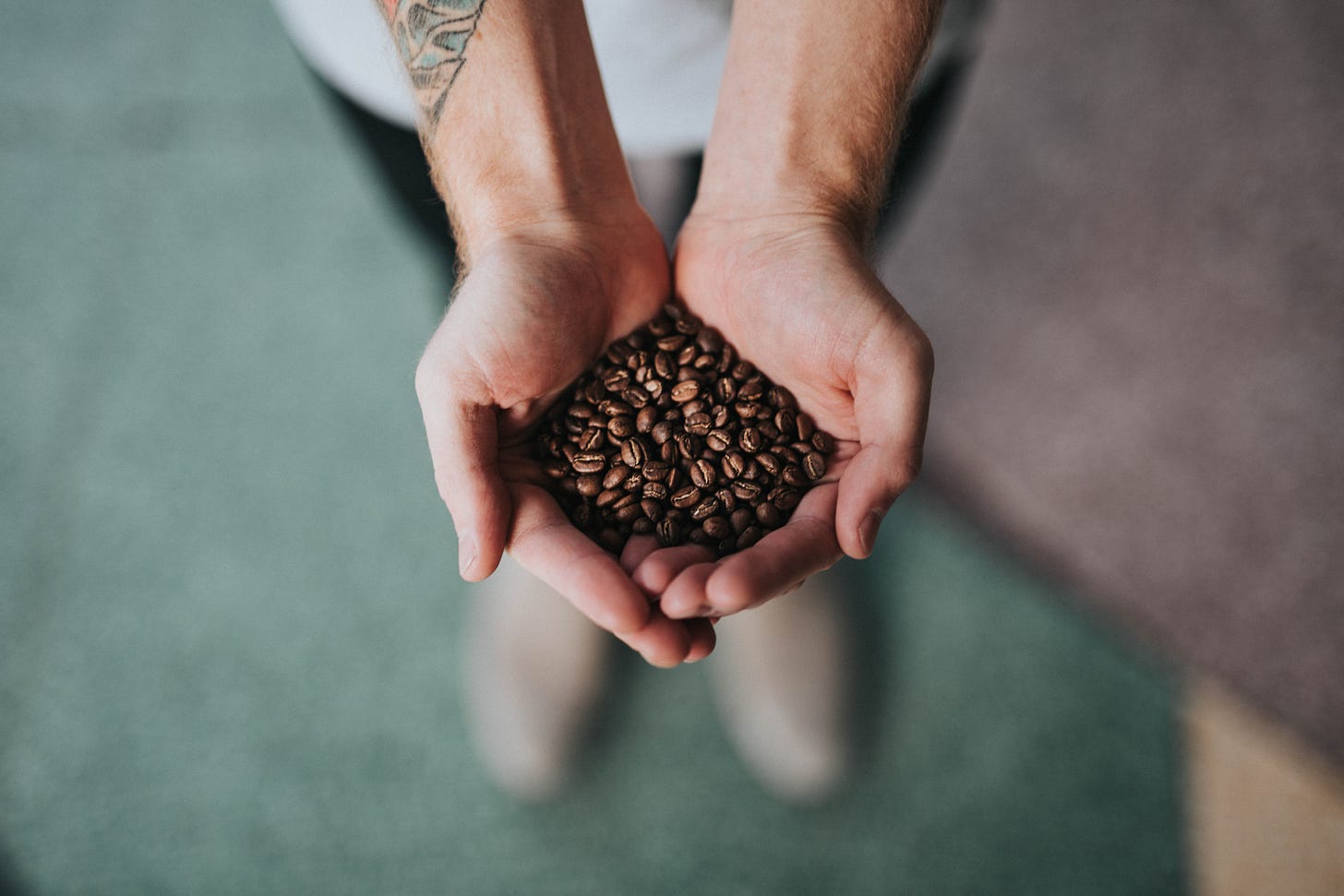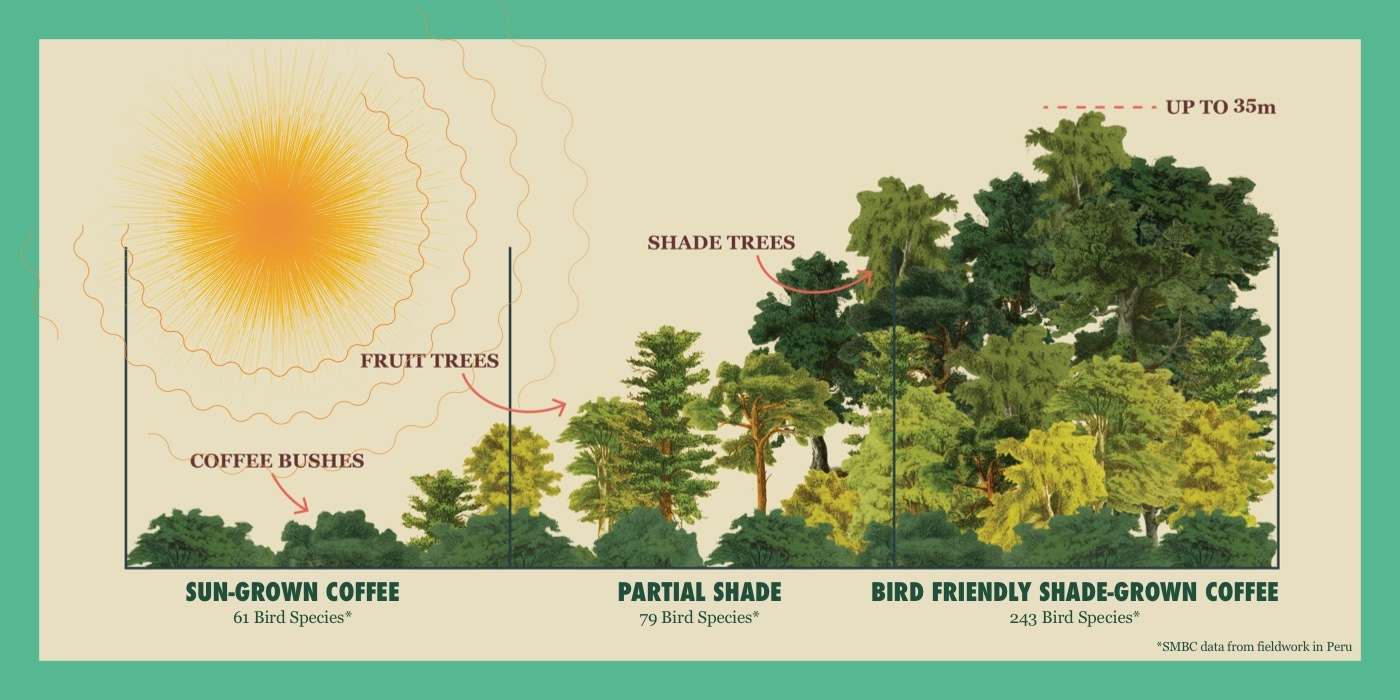This week we tackle coffee and tea. And before you shut this email, thinking, This bitch wants me to navigate the hellscape of modern life UNCAFFEINATED!, don’t worry, I’m not coming for your life force. I also need that gorgeous elixir to lure me out of bed. But North Americans gulp down 1/3 of the world’s coffee, and it’s a resource-intensive food import and a real garbage generator. (Canadians send 1.6 billion coffee cups to landfill each year, and a 2018 Greenpeace shoreline litter audit found Tim Hortons was the second-most common brand in Canadian litter.) First we’ll tackle coffee, but tea drinkers, read on — a lot of this applies to you too.
Better beans
To start, let’s zoom in on how coffee beans are grown. For one thing, a tiny cup of espresso takes 140 litres of water to make it. That’s costly in the world now, but in a future where drought is more common, coffee will be all that more precious. Agriculture is also the leading cause of deforestation, which means loss of biodiversity, soil health, and those vital, carbon-absorbing plants. A lot of coffee is also grown in poorer countries, where workers are often exposed to toxic pesticides, slave labour still exists, and where children often work beside parents for around $3 a day instead of heading to school.
So, if you can spare the extra couple bucks a bag, buy some better brew. But how do you decide what’s better or best? Let’s break down those seals on the package.
Organic (USDA or Canada Organic seal): Grown without most pesticides and herbicides. Generally a good thing, though not all organic is not a guarantee of sustainable or ethical farming practices.
Fair Trade: Guarantees farmers a minimum price and fair trade premium for their product, connects them with other farmers and distributors, and indicates certain labour standards are upheld. Useful given that we know that labour conditions in lower income countries can be particularly nightmarish. While the system has some legitimate criticisms and all the premium doesn’t make it back to the farmers, it still makes me rest easier. You can also buy fair trade certified tea, bananas, chocolate, sugar, and more.
UTZ-certified: A popular program that requires growers to meet environmental and social criteria. Part of the Rainforest Alliance. Better than nothing, but the standards for this appear to be much less rigorous than other certification programs.
Bird-Friendly (Smithsonian Foundation): This is the gold standard, and not just for birds. This coffee is shade grown, meaning at least 40% of the coffee is cultivated under a forested canopy planted with native species. This is your most sustainable growing method, and growing crops in this integrated way is one of Drawdown’s key climate change interventions. It uses 1/3 less land than its sun-grown counterpart and also absorbs carbon, restores soils, protects biodiversity, and prevents flooding and erosion. Certified coffees are also organic and pay growers premium prices.
A Smithsonian illustration of what a shade-grown coffee plantation could look like.
For years we’ve bought Coffeecology’s Café Fem Peru, which is organic and fair trade but I don’t think is shade grown. It does support female-owned businesses (and, amazingly, giving money to women and girls is not only great human-rights wise, but a top-10 climate intervention). It’s also delivered to us by bike in reusable mason jars, super delicious, and supports a local company. They also do have two bird-friendly blends. This is not #spon — if only! — and there are other great bird-friendly coffees such as Birds and Beans or the Balzac’s Atwood blend.
How (and where) do you take your caffeine?
Coffee’s a commodity crop that only grows under the right hot and humid conditions, so most coffee consumed here in Canada has a long road to travel. But, kind of astoundingly, around half of the average cup of coffee’s ecological footprint comes from the café itself, so let’s talk about how you prepare your Joe.
If you’re brewing at home, nice moves! You’ve just lowered your coffee’s carbon footprint by half and saved yourself scads of cash. (Maybe enough to buy better coffee? Just a suggestion.) But even home brewing allows for some green optimization.
If you’re devoted to your K-cup machine, you might get a refillable pod, so all those compostable grounds aren’t trapped inside plastic shells for a few centuries. That said, Nespresso devotees rejoice: short of instant coffee (shudder), aluminum-capsule coffee is the most sustainable per cup. Why? Mainly because it uses less coffee, and production is the biggest part of your java’s footprint. You want the most coffee for the least bean, so if you’re a filter-coffee drinker, worry less about the paper filter and more about using the appropriate amount of beans and not wasting what you make. You can also return used Nespresso pods for recycling.
Consider your milk, especially if you’re into lattes. A cup of black coffee has 1/16 of the carbon footprint of a latte. Raising dairy uses a ton of land and water (120L of water for 1L of milk). Any non-dairy (soy, almond, rice, oat, coconut) alternative will be better. Of the alternatives, oat milk seems to be the champ, with the least intensive growing and a small CO2 footprint. (And if the prospect buying tetrapacks or cartons bums you out, oat milk is easy to make at home.)
Compost your grounds, but don’t put them directly in the garden: A lot of gardeners (including me, roughly an hour ago) will tell your that those nitrogen-rich grounds are just perfect for your plants, but it turns out that’s a myth! They’re likely okay in your garden compost, and certainly fine if you have curbside pickup. Apparently they can be used to deodorize smelly spots, though I haven’t tried this. You can also take ’em in the shower and use them as an exfoliant to slough off that winter crust. (A spa treatment that would cost you $175 at a swanky Toronto spa.)
When you do end up at a coffee shop, reduce your impact by having your coffee to stay, in a reusable cup (only available at some places, but Tim Hortons is one) or by bringing your own to-go cup (which sometimes gets you a small discount). A new Toronto company, Reego, now piloting at a handful of Toronto coffee shops, provides a reusable takeout cup at cafés for just a $5 deposit.
If you find yourself with a disposable cup, dispose of it properly: in Toronto, coffee cups go in the garbage, EVEN IF they’re marked as compostable or biodegradable, sadly, because most commercial composting facilities aren’t set up to handle them. Sleeves can be recycled, as can lids that aren’t black, but those black lids go directly to the garbage. (If this seems like a lot, this Baronness Von Sketch skit is for you.)
But what about those who fancy a cuppa?
Tea drinkers, you’re not off the hook either, and the math is fairly similar, though tea seems to have a slightly lower environmental impact. You can shrink your tea footprint by buying loose leaf, which saves many layers of packaging — including the teabag itself. Even the ones that look like paper usually contain plastic and won’t properly compost, and those fancy “silken” ones are steeping billions of microplastic bits in with your earl grey. (And if you’re comforted by the Davids Tea “oxo-biodegradable” labelling, know that the EU is cracking down on that designation, because it is, in layman’s terms, bullshit.) Whenever possible, stick with loose leaf, which one tea expert told the CBC makes better-tasting tea and can be used for three to five brews! (And she’s British, so she’s legit.)
Like coffee, tea can carry organic and fair trade certifications. Ethical Consumer rated a bunch of very popular teas, factoring in human and environmental impacts. It skews a bit British, but there are still plenty of familiar teas on the list.
Lastly, only boil the water you need. Boiling extra water not only makes you wait longer for your beverage, but could add around 20g of emissions to your carbon tab. It’s fairly small, but there’s nothing to lose.
For the busiest people, TL;DR
If you can swing it, buy Smithsonian-certified shade-grown coffee and fair trade certified tea.
Using less milk (or plant-based milk) will really drop your impact.
Brew at home, preferably using a percolator, French press, or pour-over for coffee and a loose-leaf infuser for tea.
If you’re in a coffee shop, have your drink to stay or use your own mug to save resources and enjoy a smug feeling of superiority (priceless).
If you have a takeout cup in Toronto, only the cardboard sleeve and the lid (if it’s NOT black) go in the recycling, no matter what beautiful lies you might find on the labelling.
If you love your local coffee shop, ask them to consider a reusable mug program and to swap black plastic lids for another colour that stands a hope of being recycled.
Learn more to level up
Listen
I found this CBC interview with the Tea Lady, Henrietta Lovell, quite charming. She makes a case for indulging in a little “everyday luxury” for a few more cents a cup and at the same time improving an entire food system. “If you demand something better, the world changes.” (16 min)
Now tell me . . .
Do you have any eco resolutions for the new year? Hit reply and share them with me, and you’ll be that much closer to keeping them. Also, any time you make a change prompted by something you read here, please do tell me! My efforts are powered by your positive change.



